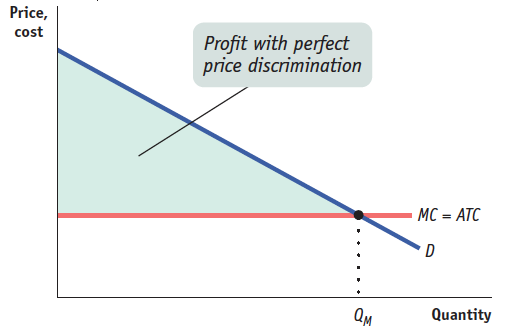Tackle the Test: Free-Response Questions
Question
Define price discrimination.
Why do firms price-
discriminate? In which market structures can firms price-
discriminate? Explain why. Give an example of price discrimination.
Rubric for FRQ 1 (5 points)
1 point: Price discrimination is the practice of charging different prices to different customers for the same product.
1 point: Firms price-
discriminate to increase their profit. 1 point: In order to price-
discriminate, firms must be in the monopoly, oligopoly, or monopolistic competition market structure. 1 point: Because rather than being price-
takers, firms in these market structures have some degree of market power, which gives them the ability to charge more than one price. 1 point: An example is different prices for movie tickets charged for people of different ages.
(6 points)
Question
Draw a correctly labeled graph showing a monopoly with a horizontal average total cost curve practicing perfect price discrimination. On your graph, identify the monopoly’s profit. What does consumer surplus equal in this case? Explain.
Rubric for FRQ 2 (6 points)

1 point: Axes are correctly labeled as “$ per unit” or “Price, cost” and “Quantity.”
1 point: The demand curve is labeled and downward-sloping.
1 point: The profit-maximizing quantity is labeled on the horizontal axis where MC = D.
1 point: The monopoly’s profit is identified as the area above average total cost and below the demand curve.
1 point: Consumer surplus is zero.
1 point: Because each consumer is charged the maximum he or she is willing to pay for each unit.